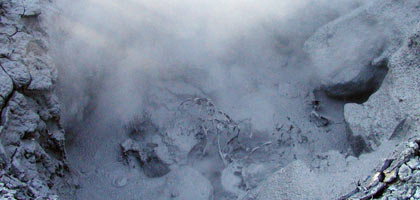| SCRIPPS INSTITUTION OF OCEANOGRAPHY, UCSD |

| the expedition | |
| the science | |
| tools & techniques | |
| japanese life | |
| daily journal | |
| the team | |
|
:: VOLCANOES :: Fuji Hakone Oshima Nii-Jima • Shikinejima Hachijo-Jima Aoga-Shima |
|
|||||||||||||||||||||||||||||||||||||||||||||||||||||||||||||||||||||||||||||||||||||||||||||||||||||||||
Gas Sampling

The sampling techniques for the gases need to be simple, fast and without complicated equipment that could break or stop working in the harsh conditions of an active volcano. The tools need to be light-weight and small because we will carry them on our backs up the steep slopes and move between islands by helicopter. Because we have limited time and because working on active volcanoes is dangerous, the sampling of the gases must be fast and efficient. The sampling techniques for gases have been refined over the past four decades by scientists working on active volcanoes and hydrothermal systems all over the world.
To collect samples we use a 1-inch-diameter, 1-meter-long tube made out of titanium (heat resistant to 400 degrees Centigrade) for the high temperature gases or a plastic funnel for the lower temperature bubbling hot springs. In the case of sampling gas vents (fumaroles) we insert the tube into the vent. The tube is connected to the sampling flasks by a flexible silicone rubber tube (3/8 inch diameter). In the case of bubbling hot springs we invert the funnel over the bubbling spring so that the bubbles of gas collect in the funnel and silicone tube. On the other end of the silicone rubber tube are our sampling flasks. This sampling technique is so versatile that we can use it at high temperatures, low temperatures, fumaroles, bubbling springs and mud pots, even underwater by scuba diving.

We collect two kinds of gas samples using two kinds of flasks. Both flasks are connected to the silicone tube in series. This allows us to flush out any air from the tubes very efficiently until the tubes are completely purged of air. The first sample bottle in the series is a small (about 3 inches long and 1 inch in diameter) glass bottle with a high vacuum valve. This bottle has been evacuated in the laboratory before and by opening the valve gas is allowed to enter the bottle. After sampling the valve is closed and the gas is trapped inside the bottle until it is released again in the laboratory for the analyses. This sample is collected specifically for the analyses of the noble gases and carbon dioxide (see below). The second sample bottle is called the Giggenbach bottle, named after the geochemist who invented and refined the gas sampling technique in the early 1970's. This sample bottle is larger (about 5 inches long and 3 inches in diameter), made out of glass and equipped with a Teflon valve. To understand how this bottle works it is necessary to know a little about the composition of volcanic gases.
All volcanic gases are made up mostly of water vapor. In fact at continental margins the gases are sometimes 99% water vapor. It is the remaining one percent of the total volume that holds all other gas species, including carbon dioxide, sulfur dioxide, nitrogen, methane, and the noble gases like helium and argon. So, because volcanic gases are essentially water vapor we either need to collect a lot of gas or have very sophisticated analytical techniques to analyze the remaining one percent that holds the information we find the most useful. In the case of carbon dioxide and the noble gases the analytical techniques in Dave Hilton's laboratory at Scripps are very sophisticated such that they allow the precise analyses of these species at very small concentrations. Therefore collection of a small sample is sufficient. However, we do not just want to know about carbon dioxide and helium but also about all the other species that make up the gas discharging from the volcanoes. In order to make those analyses we need to collect the sample with the Giggenbach bottle. The key feature about this bottle is that it contains a very pure solution of NaOH (caustic soda) to absorb sulfur and carbon dioxide. Water also condenses into this solution. The remaining gases fill up the previously evacuated space of the bottle and become concentrated in this way.
